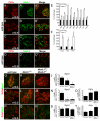Nkx6 transcription factors and Ptf1a function as antagonistic lineage determinants in multipotent pancreatic progenitors
- PMID: 20627083
- PMCID: PMC3133668
- DOI: 10.1016/j.devcel.2010.05.015
Nkx6 transcription factors and Ptf1a function as antagonistic lineage determinants in multipotent pancreatic progenitors
Abstract
The molecular mechanisms that underlie cell lineage diversification of multipotent progenitors in the pancreas are virtually unknown. Here we show that the early fate choice of pancreatic progenitors between the endocrine and acinar cell lineage is restricted by cross-repressive interactions between the transcription factors Nkx6.1/Nkx6.2 (Nkx6) and Ptf1a. Using genetic loss- and gain-of-function approaches, we demonstrate that Nkx6 factors and Ptf1a are required and sufficient to repress the alternative lineage program and to specify progenitors toward an endocrine or acinar fate, respectively. The Nkx6/Ptf1a switch only operates during a critical competence window when progenitors are still multipotent and can be uncoupled from cell differentiation. Thus, cross-antagonism between Nkx6 and Ptf1a in multipotent progenitors governs the equilibrium between endocrine and acinar cell neogenesis required for normal pancreas development.
Copyright 2010 Elsevier Inc. All rights reserved.
Figures




References
-
- Apelqvist A, Li H, Sommer L, Beatus P, Anderson DJ, Honjo T, Hrabe de Angelis M, Lendahl U, Edlund H. Notch signalling controls pancreatic cell differentiation. Nature. 1999;400:877–881. - PubMed
-
- Briscoe J, Pierani A, Jessell TM, Ericson J. A homeodomain protein code specifies progenitor cell identity and neuronal fate in the ventral neural tube. Cell. 2000;101:435–445. - PubMed
Publication types
MeSH terms
Substances
Grants and funding
LinkOut - more resources
Full Text Sources
Other Literature Sources
Medical
Molecular Biology Databases

